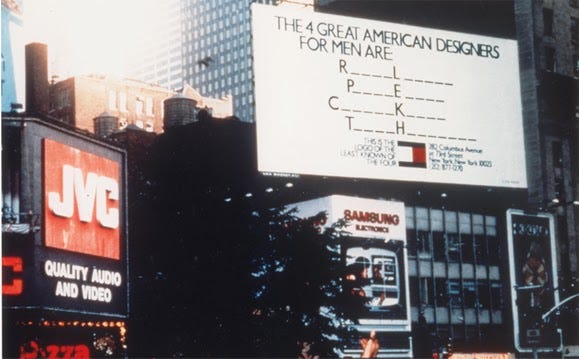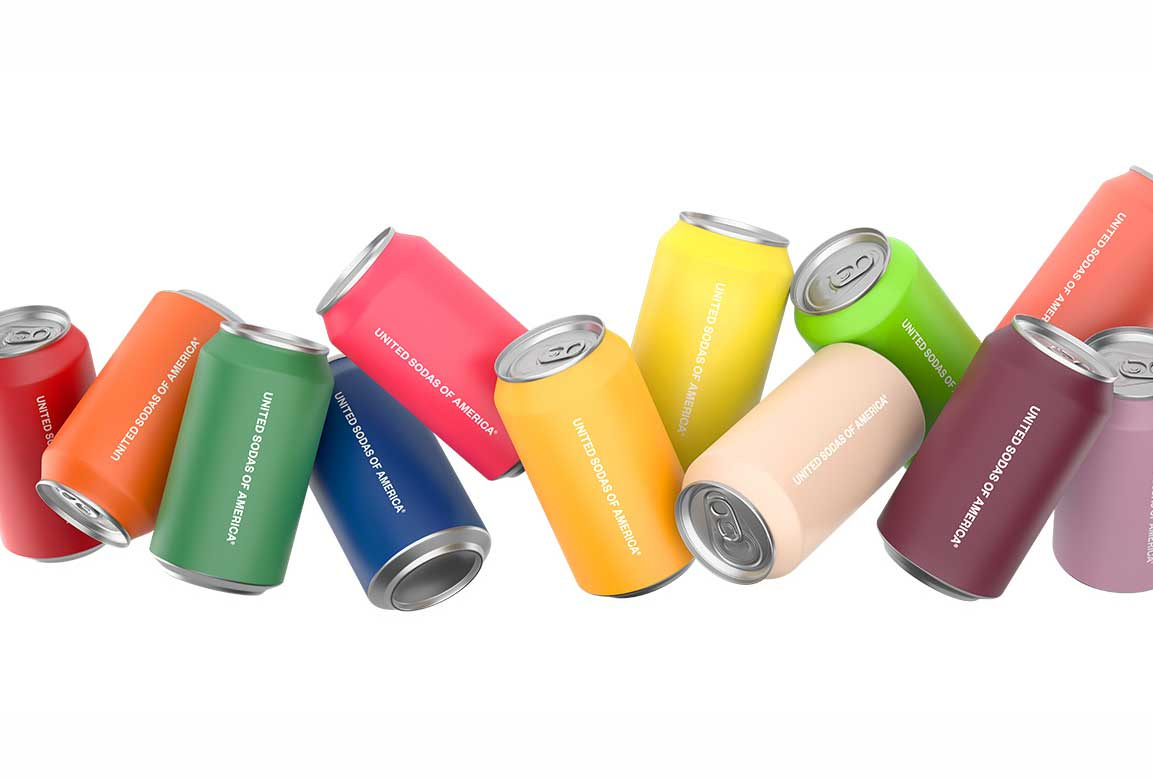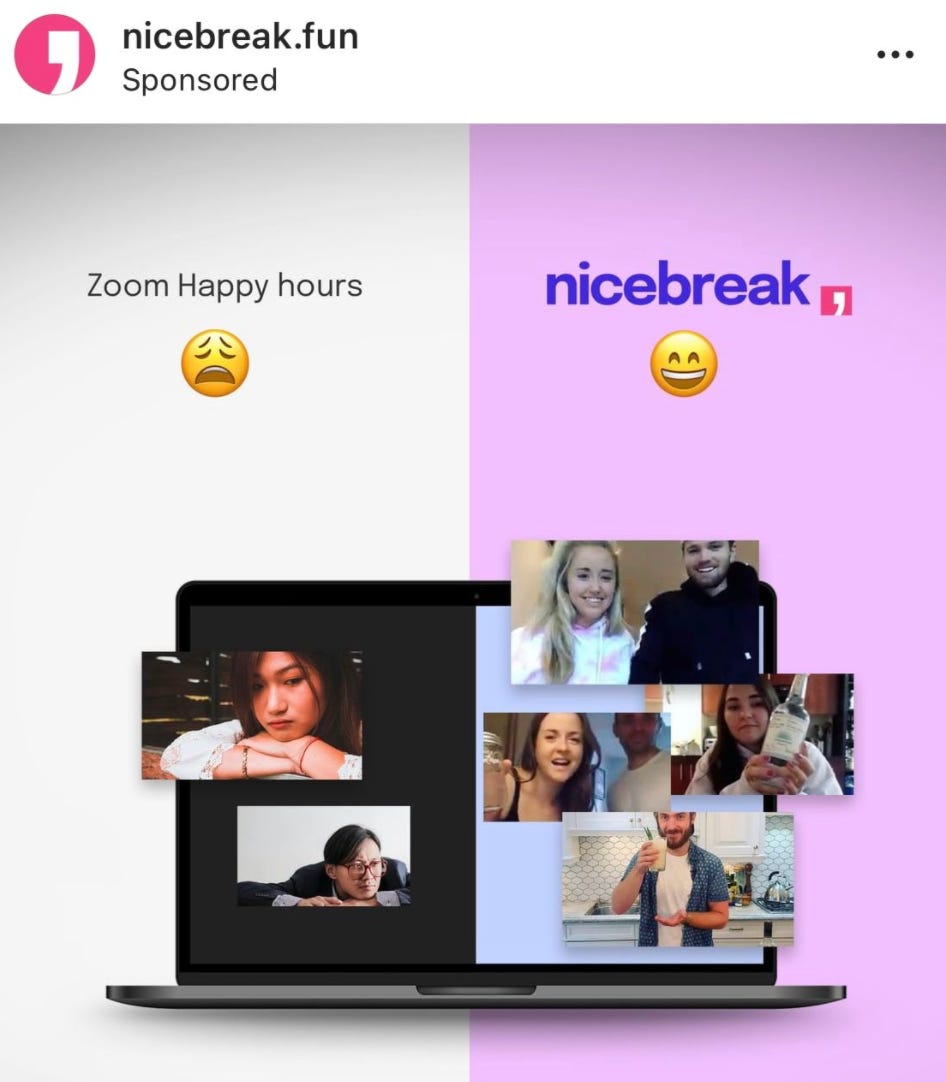I Saw The Sign
A fitting tribute to attorney Steve Barnes.
A newsletter about branding, startups, and mission-driven companies aiming to make the world a better place.
👋 Welcome to For The Love, so happy to have you all here!
Today we’ll be discussing:
How United Sodas of America went out-of-home when everyone was in their homes
A roundup of new launches this week, including eggs “made by chickpeas, not chicks."
The cure for Zoom fatigue, apparently
If you were forwarded this by a friend, join over 2,000 other DTC enthusiasts by subscribing here!
⚡ For The Love of Branding
In 1985 a mysterious new billboard went up in Times Square…
A fill in the blanks puzzle.
For those of you not familiar with 1980’s menswear, the missing names are Ralph Lauren, Perry Ellis, Calvin Klein, and one that was unknown at the time — Tommy Hilfiger.
For his debut, Tommy Hilfiger wanted to go with tried and tested “models on a beach,” however, he gave in to his team and art director George Lewis and the ads ran. (Spoiler alert: he would go on to subject us to models on beaches for years to come.)
It was bold, attention-grabbing, and intriguing. It basically said, if you didn’t know his name, you should.
And guess what?
It worked. People learned his name.
Billboards are still used to advertise, but not often by new brands.
Now we have digital advertising, which is more appealing for many reasons — cost, reach, and analytics. Every click, website visit, and purchase can be attributed to a specific ad, which is a great tool, for generating sales and also for learning about your customer and refining your brand.
But there’s still a place for OOH (out-of-home) advertising.
This is very obvious to anyone who lives in New York and rides (or rode) the subway. No need for Techcrunch — just look to your nearest subway car to find out what DTC brand just raised their Series A.
Although you likely already knew their name, having been plastered all over your Instagram feed for 6-12 months.
United Sodas of America took a different approach.
Within three months of launch, their name (and cans) started popping up across Manhattan and Brooklyn.
United Sodas is a better for you soda brand, using all-natural ingredients and clocking in at 30 calories (compared to Coke’s 140).
Each of their sodas is named for its fruit flavor, with a corresponding can color.
They’ve pared back everything — what goes inside the can, and on the outside.
Unlike most soda cans which are covered in text (including values, history, and both ingredients and nutritional information on the front *and* back), they chose to highlight only what’s most important — the ingredients.
Even their brand name is on the back of the can.
Co-founder and CEO Marisa Zupan explained to me:
“Our hypothesis was, everything's really busy, we're going to minimalize it extremely and see what is actually in the decision-making process...And we had confidence that consumers know how to turn a can around and look at the nutritional panel and make a decision for themselves. Turns out that this is all actually functioning very, very well...Everyone who is purchasing our product at retail seems to know that they're buying a soda that tastes like strawberry, or sour blueberry, or young mango. And they all seem to know that it's our brand.”
Like their approach to packaging, they’re taking an unorthodox approach to marketing.
While they are using all the traditional digital channels, they also decided to buy into billboards soon after launch for a few reasons.
Objects in billboard are smaller than they appear.
According to Marisa, part of the decision to invest in OOH was “about making sure that people understood that we weren't just another Instagram brand that you only see on Instagram and you shop on Instagram. There's something about the difference between only interacting with a brand on this tiny little screen, where the ads all look the same, versus seeing it on a billboard...There's so much more dimension when you have different narratives.”
On top of adding another dimension to the brand and expanding the narrative that consumers see, it adds credibility (as Tommy Hilfiger discovered).
We are used to seeing billboards from established brands, usually the only ones ready to commit the ad dollars, so we tend to associate any brand with a billboard with that level of success and legitimacy.
As Marisa said, “it does really speak to the legitimacy of a brand. And that's important, because when you're a new brand, and you are new to the industry, it's helpful if people think of you as a legitimate new player...so out of home gets you there, and can do that quite efficiently.”
Invest in yourself, it pays the best interest. (As the Instagram gurus say)
While United Sodas of America is primarily A DTC brand, they also had their sights set on the shelves of select, specialty retailers.
“For us, it was also a B2B play in some ways, to say ‘we're here, check us out, we're legit. We have great products, and we're a real company with real presence.’”
It helped buyers get over the hump of taking a risk and convincing them to invest in the brand. It showed that they're a serious player worth investing in (both in dollars and shelf space).
Added bonus?
“It also created a lot of inbound interest. It created a lot of interest that we weren't necessarily, going for, with high visibility individuals, like celebrities.”
"You try to be greedy when others are fearful. And you try to be fearful when others are greedy." (*Not* from Instagram — this one’s from Warren Buffet)
“When everybody's running the other way, we ask, ‘why are they running the other way? Is there opportunity where they're running from?’ And in certain ways, that's how we started the brand. And it's also sometimes how we strategize around our marketing. So if everyone's on Instagram, maybe it's time to think about platforms that people aren't on, or aren't using right now.”
When the pandemic hit and most brands suspended their OOH spending, United Sodas doubled down.
“Our out-of-home strategy became more robust than we anticipated...with more placements, better placements, longer placements...It really allowed us to get more creative and to play bigger in that channel without necessarily spending as much as we would in normal times.”
So those are the reasons why, but a successful OOH campaign also requires a few things done very well — namely the when, where, and what.
WHEN: Timing (Is Everything)
It was no coincidence that their billboards went up in the Springtime. Marisa explained it’s because “that’s soda season, that's our Super Bowl — end of May to early September. And that's when everything ran. So if we're going to do big statement pieces again, then it would definitely be in that time...it certainly worked for us.”
WHERE: Location (Location, Location)
As New York residents, the United Sodas team decided that’s where they should start — in places they knew were high traffic and would reach the people they wanted.
“We know this market, and we know how it works because we live here. So in the decision-making process of where the placement is, we have an intuition to know what’s right, and what’s not right...We knew exactly the moment the billboard went up because we walked by it.”
Understanding the lifestyle of New Yorkers gave them insights they wouldn’t have had otherwise. Specifically, that they’re likely walking by them.
“In New York, there's sort of an intimacy to the placements. We wanted to make sure that we had them at a human level so they were visible from the ground up — when you're standing, you didn't have to look up too much to see them.”
All the knowledge gathered from this campaign will help them when they expand OOH to other markets.
“Now that we have broad strokes of understanding the benefits of out-of-home, we're going to be much more prepared to launch in markets where we're less intuitively familiar with what's going on, and with how people interact with things.”
WHAT: The Creative (Keep it simple, stupid.)
Even though their billboards went up when they were a very new, and largely unknown brand, they didn’t try to tell their entire story or even their value proposition in the ads. They let the creative speak for itself — prioritizing noticeability and shareability and sparking curiosity.
“A lot of people try to do a lot of explaining in billboards, and every brand is a little bit different, but for us, the benefit of having such a huge canvas is to visually show something amazing and beautiful. So we kept it really simple. We highlighted the product. We basically leveraged the best things, the strengths of our brand, which is the visuals, and the brand name, we made those really, really, really, really big, and we didn't try to put a lot of explanatory copy...It really ended up creating sort of a memory sticker in people's minds that was impactful.”
Whether it’s a can, an Instagram ad, or a billboard, always keep in mind the larger vision. As Marisa told me:
“A brand isn't just a wrapper around a product, a brand is a platform, and a product happens to be one of the things that express the brand. Ultimately, what we're doing is creating an entity that interacts with people, communicates ideas, and creates products.”
🔥 For The Love of Newness
Peggs, planted-based eggs “made by "chickpeas, not chicks," that use ~90% less land, water, & energy to produce,” launched their Kickstarter.
Also newly launched on Kickstarter — a pillow fort!
Great Jones and fashion darling Rosie Assoulin collaborated on a “Party Towel,” which I think is a placemat.
Harry’s launched Headquarters (at Walmart?) — a new line of scalp-focused haircare.
In other DTC-goes-corporate news, Golde launched supplements with Target.
Also, Parachute created an exclusive collection for Crate & Barrel.
💡 For The Love of Interestingness
From streetwear to skincare, pretty much every brand I speak to is focused on community-building. If you’re one of them (or just want to learn about building a community), On Deck now has a Community Builders Fellowship, “where fellows learn how to create communities, get them off the ground, and sustain the magic as they scale.” You can apply here.
🔍 For The Love of the Details
From what I can tell, Nicebreak is just a box of alcohol — and that is *definitely* not a cure for the serious depression the people on the left are going through.
I mean, that’s presumably how they showed up to a “Happy Hour”.
Also, do they think that only Asian people are having a tough time with all the Zooming? I’m pretty sure that’s something people from all backgrounds can unite behind.
How about starting out with a more relaxed dress code? Has this guy been forced to wear a sports jacket on Zoom for the past ten months?
That would certainly have an effect on anyone’s mental health.
In all seriousness, not every call needs to be on video or require pants. Just make sure you align the two properly for the sake of your career.
Thank you for being part of For The Love!
A few more things...
Is there a topic you think I should cover? Or a funny ad I can dissect? I’d love to hear from you! You can email me at info@ajasinger.com, respond to this email, or drop it in the comments ⬇
Know someone who’d enjoy this newsletter?
Was this newsletter forwarded to you?
Written by Aja Singer, a brand and creative strategy consultant interested in all things startup, mission-driven, and community. Born in Canada. Based in Brooklyn. You can also find me on Instagram and Twitter.







